
Rouvy has just done what everyone has been asking for: Added virtual shifting to Rouvy, using Zwift hardware*. This allows you to use virtual shifting in Rouvy, just the same as Zwift, using the Zwift Click or Zwift Ride hardware. You technically don’t need the Zwift Cog at all, leaving your existing regular cassette on there. But we’re probably getting ahead of ourselves.
This announcement is a pretty big deal. Over the last year or two, Zwift has heavily pushed not just consumers but trainer manufacturers, to adopt Zwift Cog & Click. In fact, almost every trainer manufacturer except Garmin/Tacx has fallen in line. And while Zwift Cog & Click does have some substantial benefits for multi-bike compatibility (for both consumers and Zwift), its main downside is that Zwift has heavily guarded this as Zwift-only. Thus, anyone who bought a Zwift Cog-enabled trainer was effectively locked into Zwift from an app standpoint.
By Rouvy removing that wall, this means consumers can buy any trainer they please, and use it with not just Zwift, but also Rouvy (and I’m gonna guess, soon, any other app they darn well want). Now, to be really clear here: This is hardly some olive-branch move by Zwift to the indoor training community. Rouvy has done the challenging work of reverse engineering the communications of the Zwift Protocol, and simply implemented it in Rouvy. So, let’s dive into it.
*Now, for a tiny bit of nitpickers corner, technically speaking, a small independent app called QZ has added this a while back for other platforms, but that requires a bunch of middle-man configuration and another app. Which isn’t an insult to that app (they also do treadmill incline stuff too), but that’s much more of a geekery shim/solution than a mainstream solution.
Hardware Required:
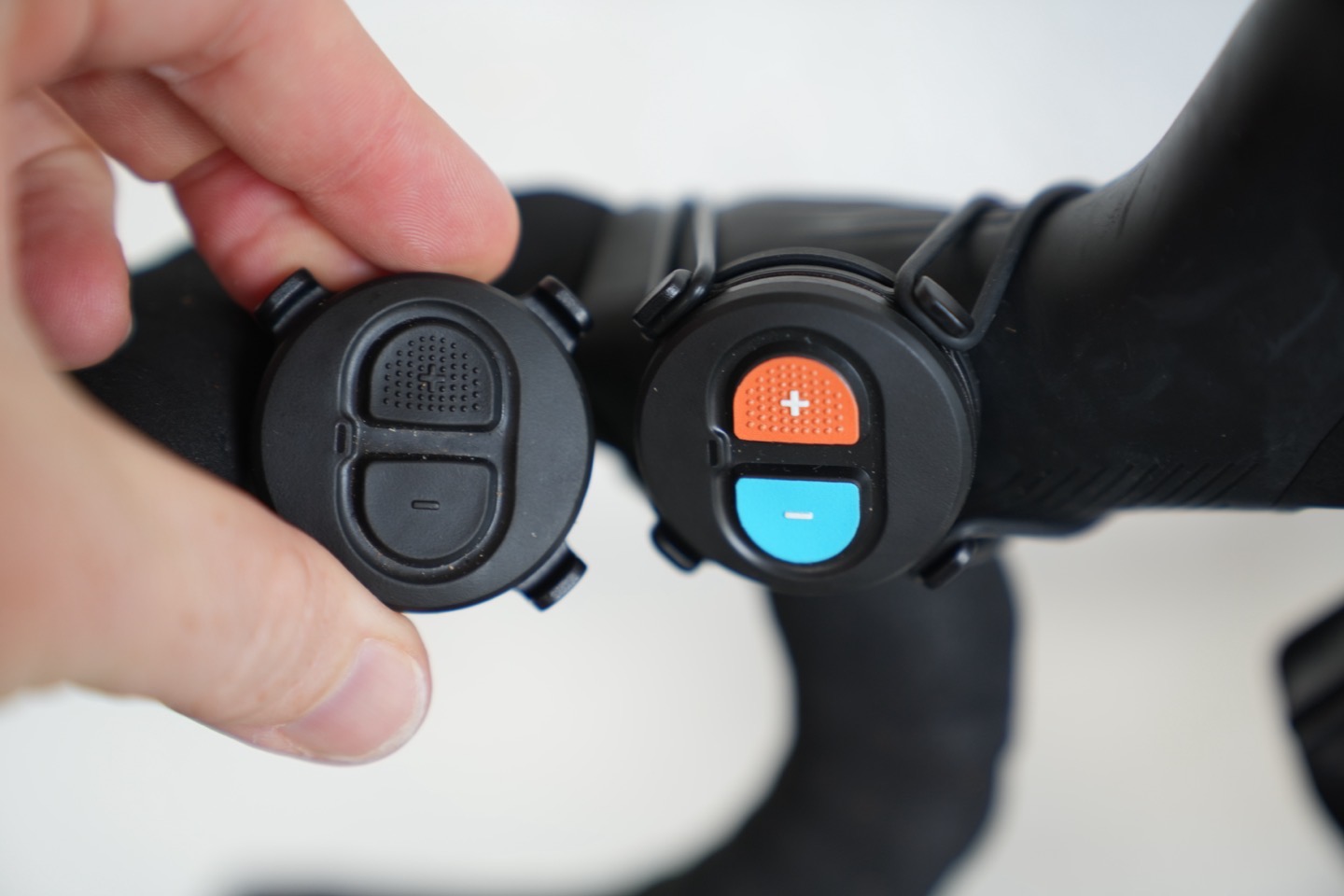
The first thing is having the right hardware, which is essentially:
A) A trainer on the Zwift Virtual Shifting compatibility list*
B) The Zwift Click, or Zwift Ride frame
Note that Zwift Play isn’t supported at this time, and it doesn’t sound like it will be either. Rouvy sees Zwift Play as a bit problematic since it takes up two Bluetooth channels (limiting usefulness on Apple TV, which is effectively the same problem Zwift has with it).
When it comes to the trainers, officially the list is any trainer on the Virtual Shifting compatibility list. But in practice, that’s a bit more variable. Rouvy says they’ve tested all of the Wahoo ones on that list, and those all work. Meanwhile, I tried with the Elite Direto XR COG, and that didn’t work. Inversely, I tried with the Decathlon D100, and that *did* work.
In asking Rouvy about this, they acknowledged it may take a bit of time to work through all trainers on that list, as they’re finding slight differences in how each company has implemented the virtual shifting from a protocol standpoint.
*(Note: Rouvy stresses to ensure that you’ve got your trainer firmware fully updated to the latest version, since that’s the version they’ve been doing compatibility testing on.)
Note however, that the Zwift Cog is *NOT* required. That’s because the Zwift Cog has no technical smarts in it. It doesn’t connect to anything from an electronics standpoint. It’s merely in place of a cassette. To demonstrate that, I simply used the Decathlon D100 with a regular cassette and the Zwift Click:
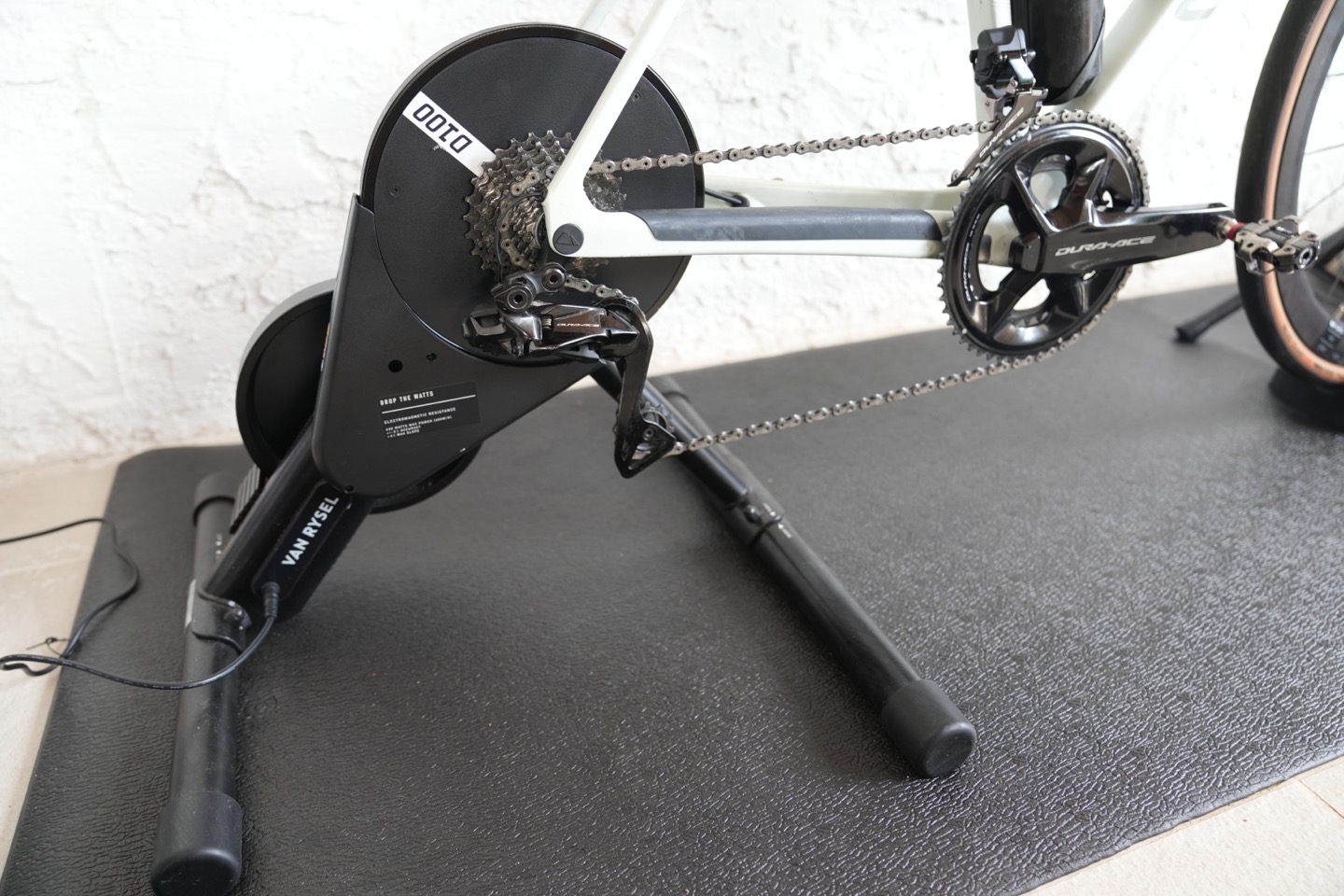
Meanwhile, up on the handlebars, you need either the Zwift Click, or the Zwift Ride Frame (which has integrated handlebars built-in). The Zwift click can be either the black one, or the colorful one. Those are internally identical, merely differ in paint job.
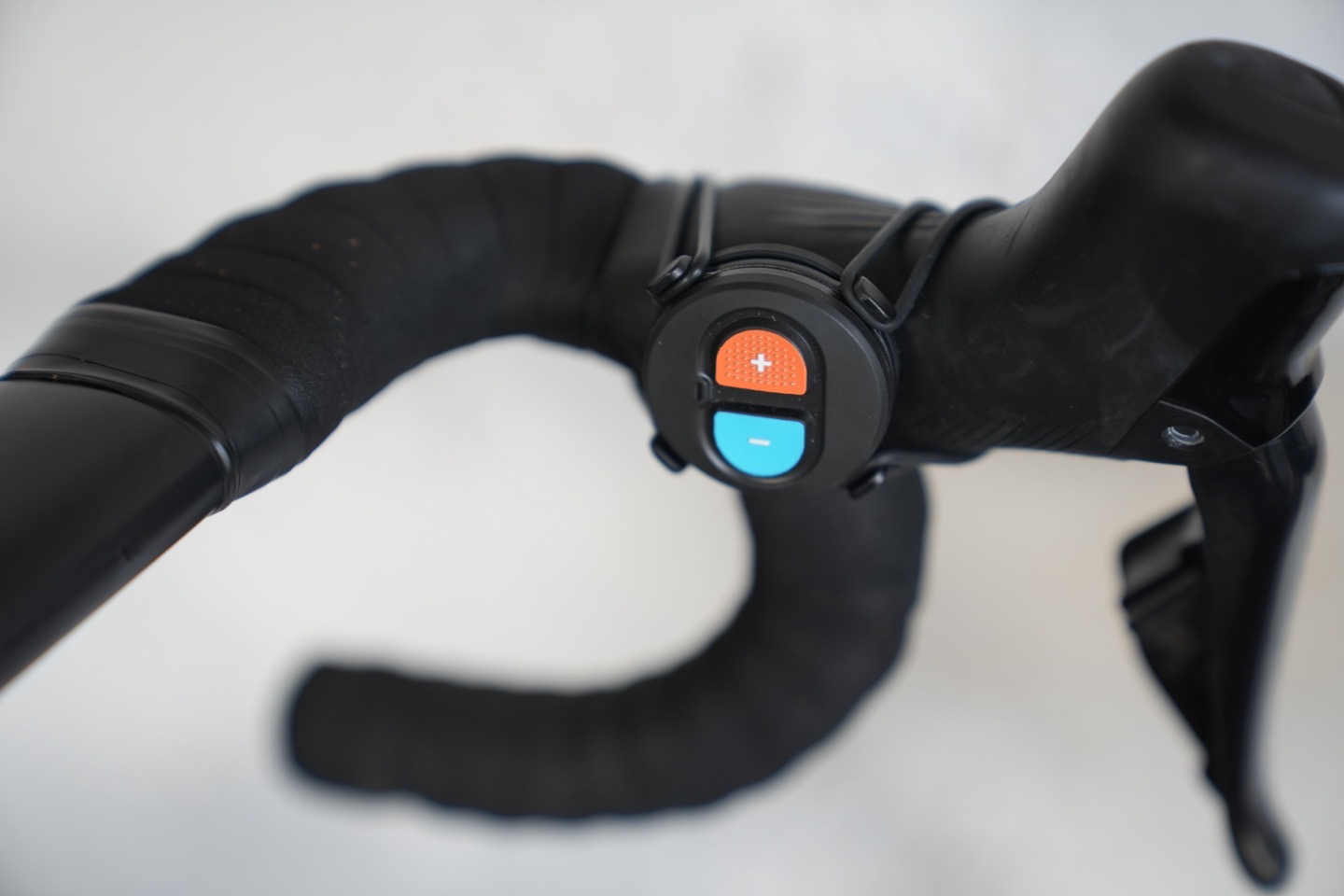
Got all that? Good.
Setup and Config:
Now, crack open Rouvy (remembering to update it first, obviously). You’ll see a ‘What’s new’ screen here, touting the new connectivity:
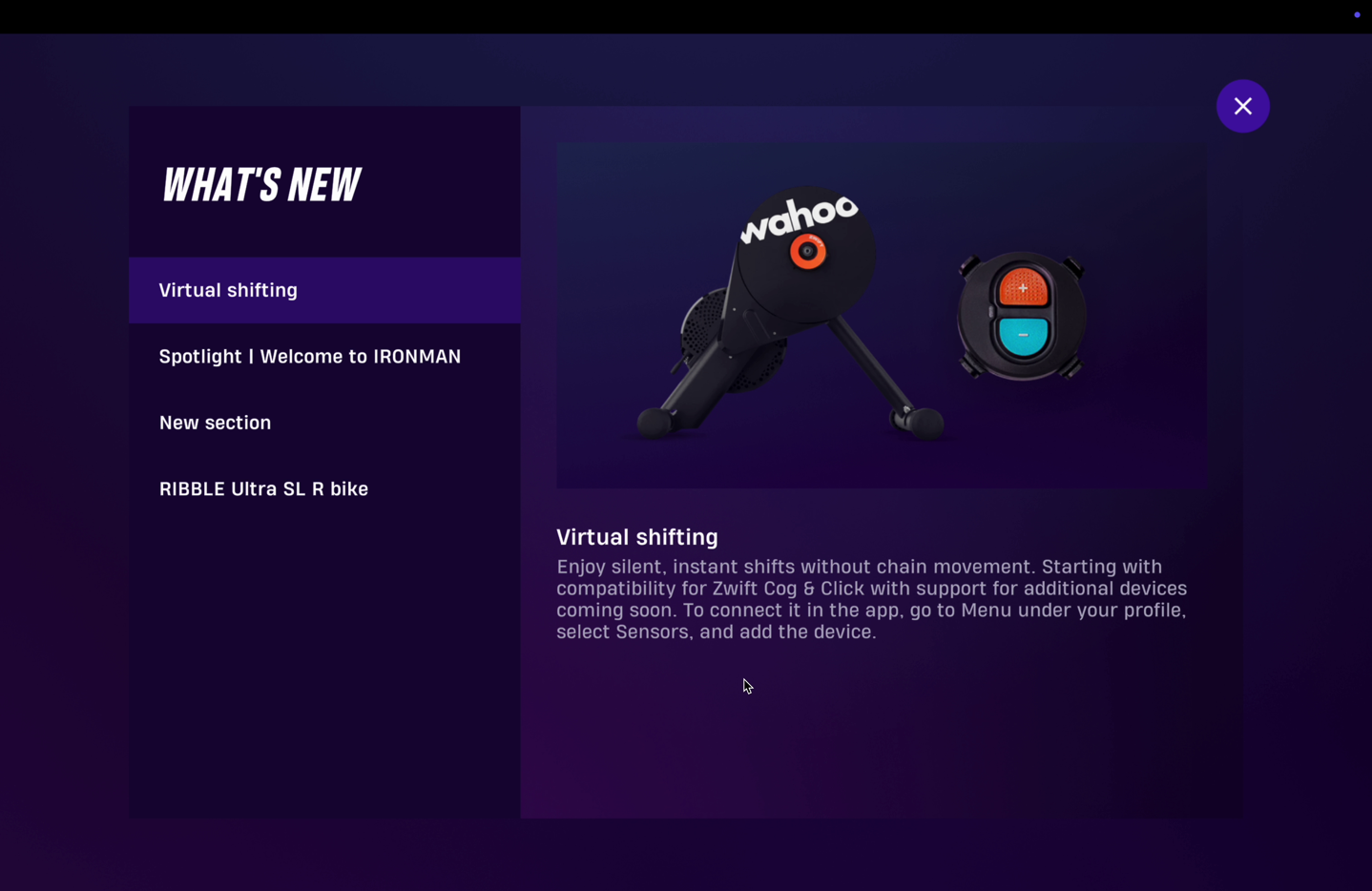
Then, pair your trainer like normal.
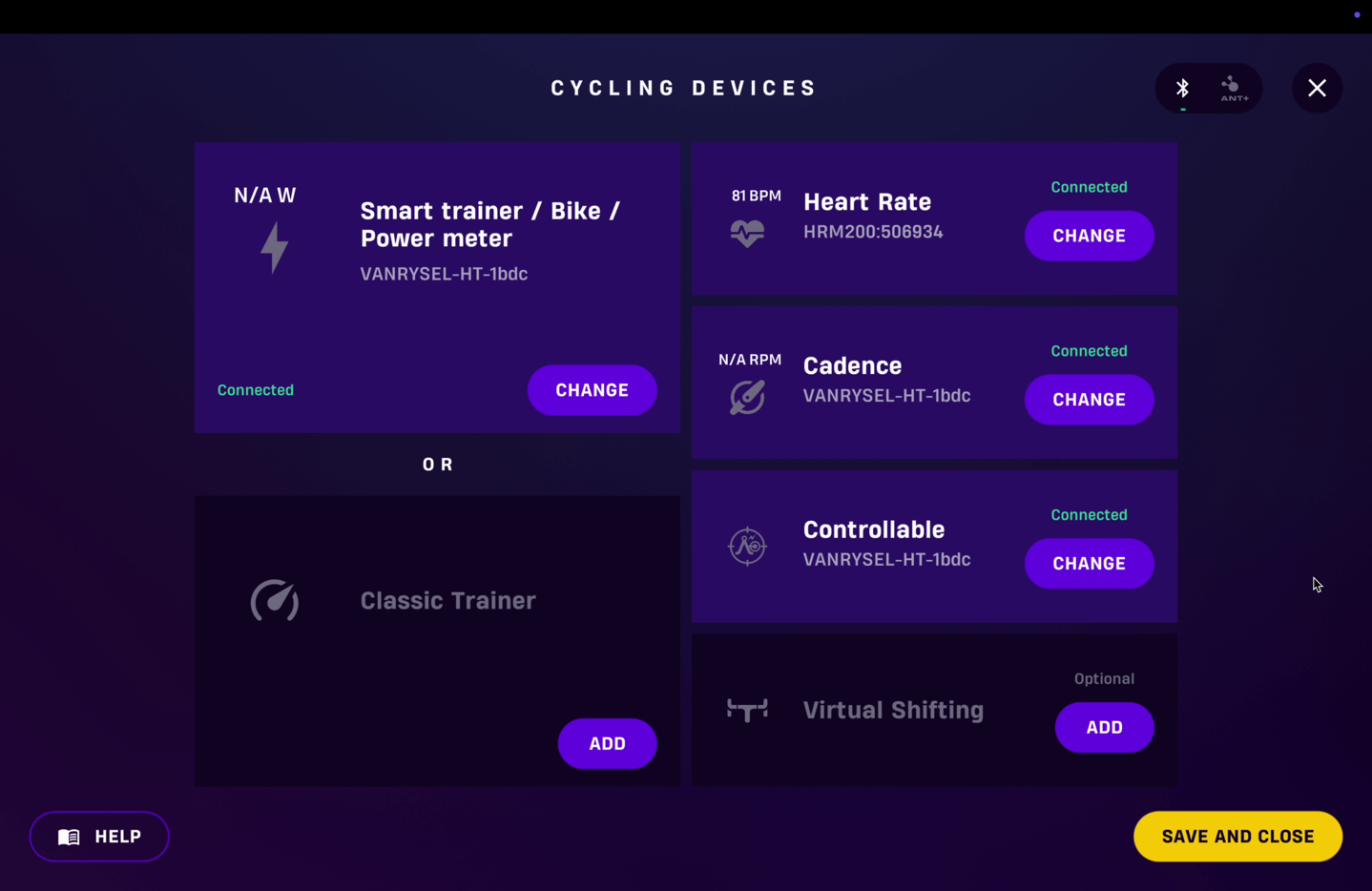
Once you do that, you’ll see the new Virtual Shifting option, which is where the Zwift Click will show up:
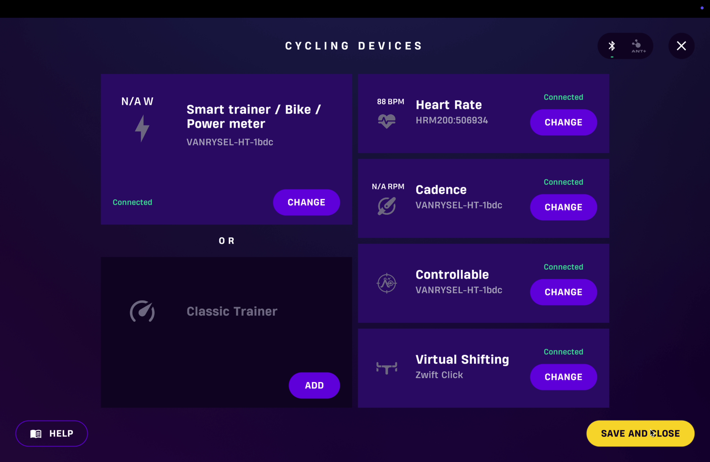
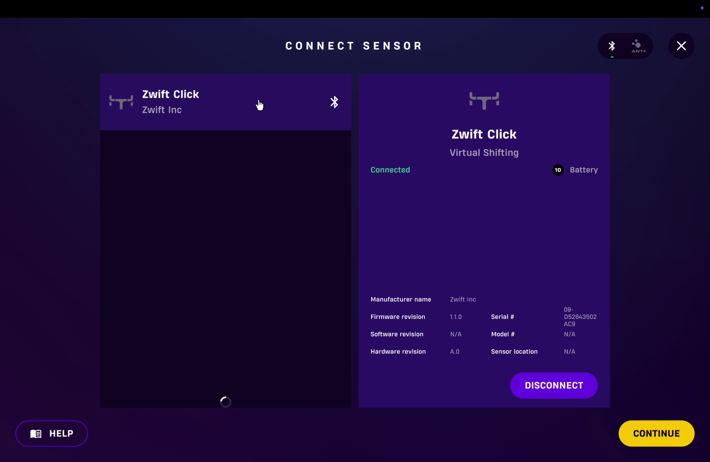
At this point, you’re ready to go and start using it in-game.
Riding With It:
At this point, pick a course you want to suffer on (just like normal). In my case, I decided to go with something at the other end of the island, Cap de Formentor:

You’ll notice in the upper left corner is the gearing display (e.g. Gear 16). In this configuration, you’ve got Gears 1-24, and you simply shift through them by pressing the + or – icon on the handlebar. Higher is harder, lower is easier. Just as with Zwift, the responsiveness is instant, and you can very quickly iterate through them. In doing a few test rides, I’m not seeing any difference that I can tell between Zwift and Rouvy here, in terms of responsiveness (and trainer control).
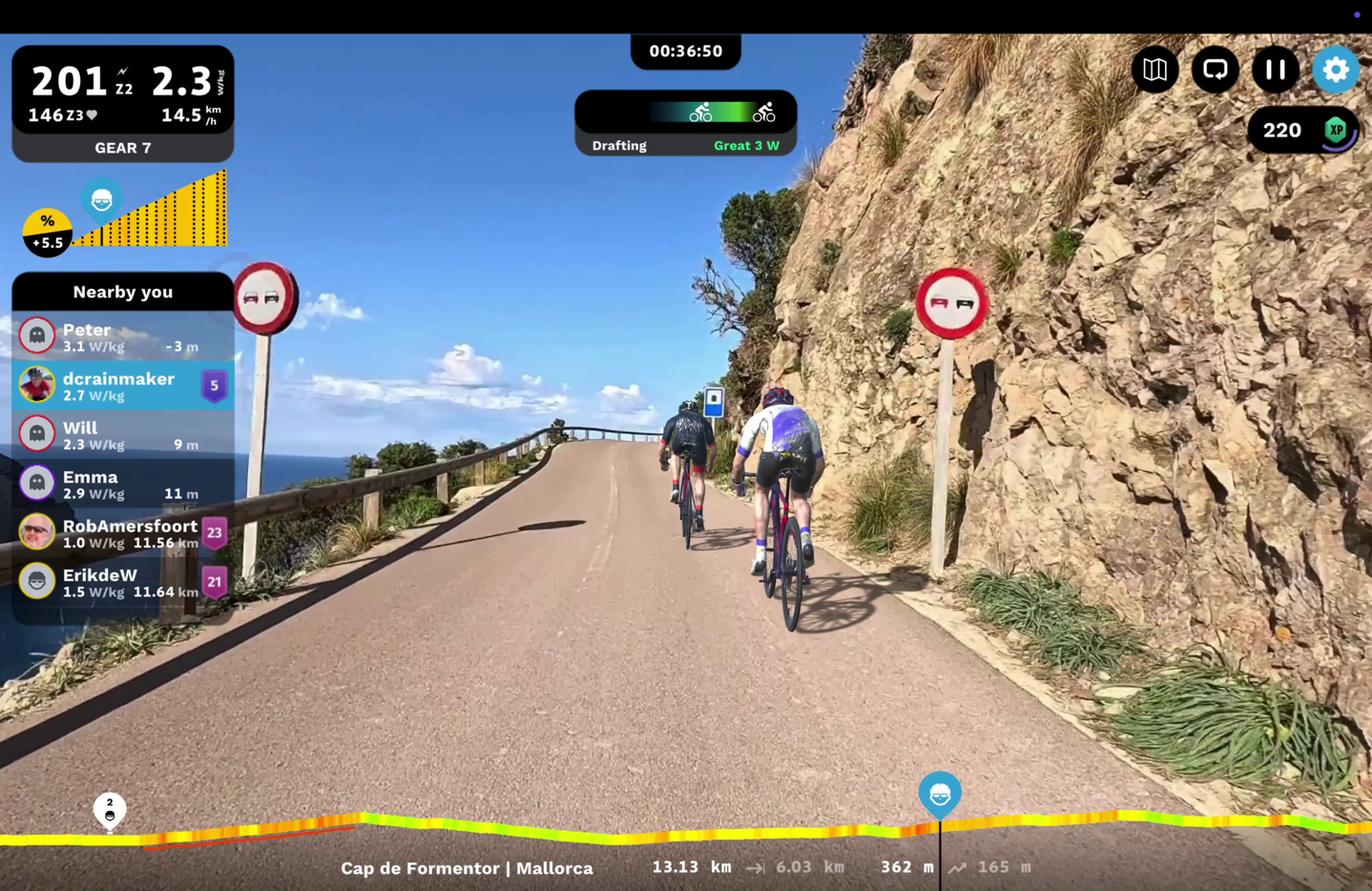
Likewise, when it comes to how the trainer feels, all of this feels identical to Zwift for me at this point. Perhaps long-term testing would yield different results, but at this point, it feels all the same. And that makes sense. The trainer itself already has special firmware for Virtual Shifting, and Zwift (now Rouvy) is simply telling it which gearing to use, based on each time you click.
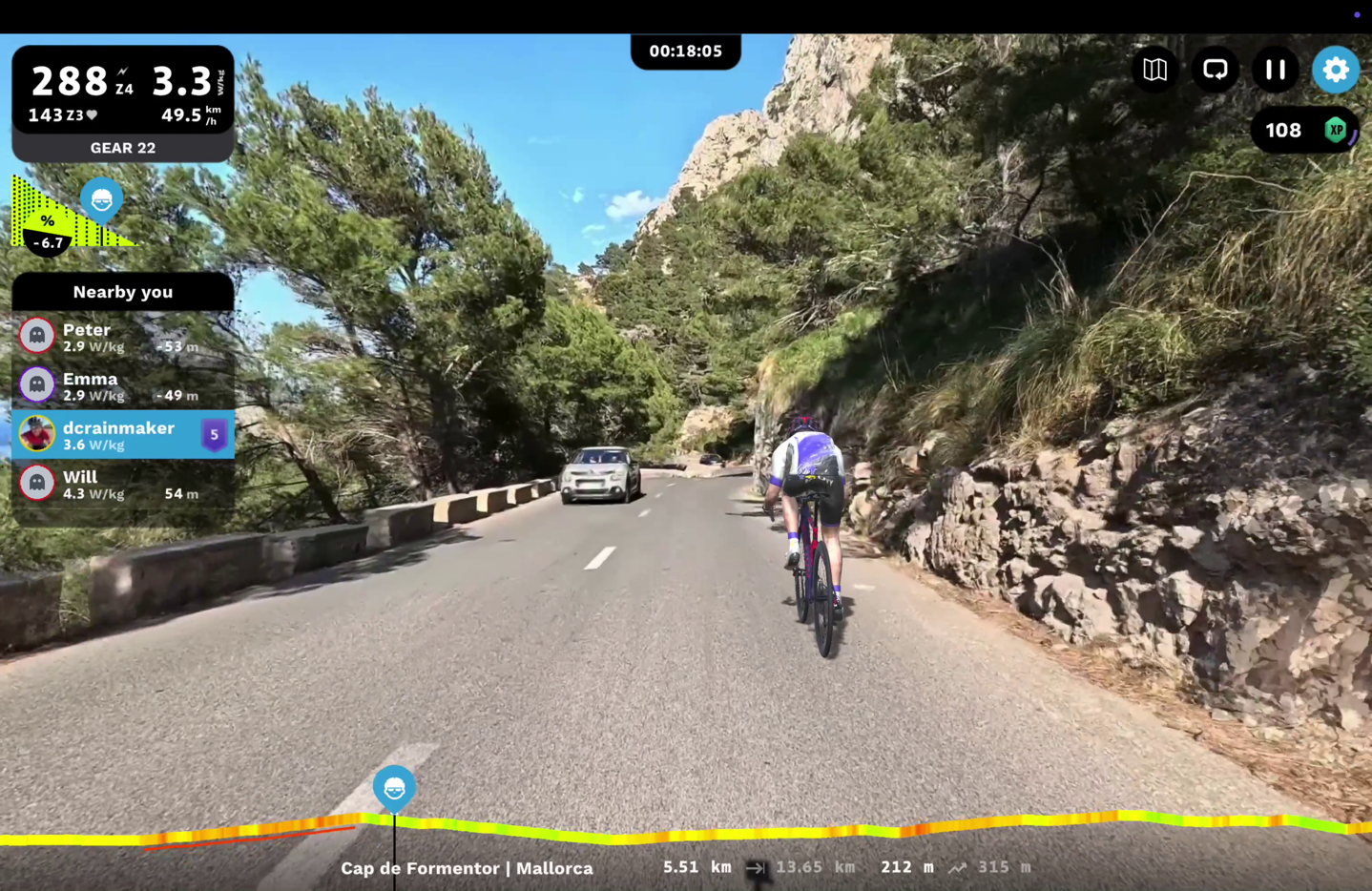
Albeit, while Zwift did very recently roll out SRAM-style shifting and drivetrain combos on the Zwift Play & Click, that hasn’t happened here yet. But hey, the year is still young.
Wrap-Up:
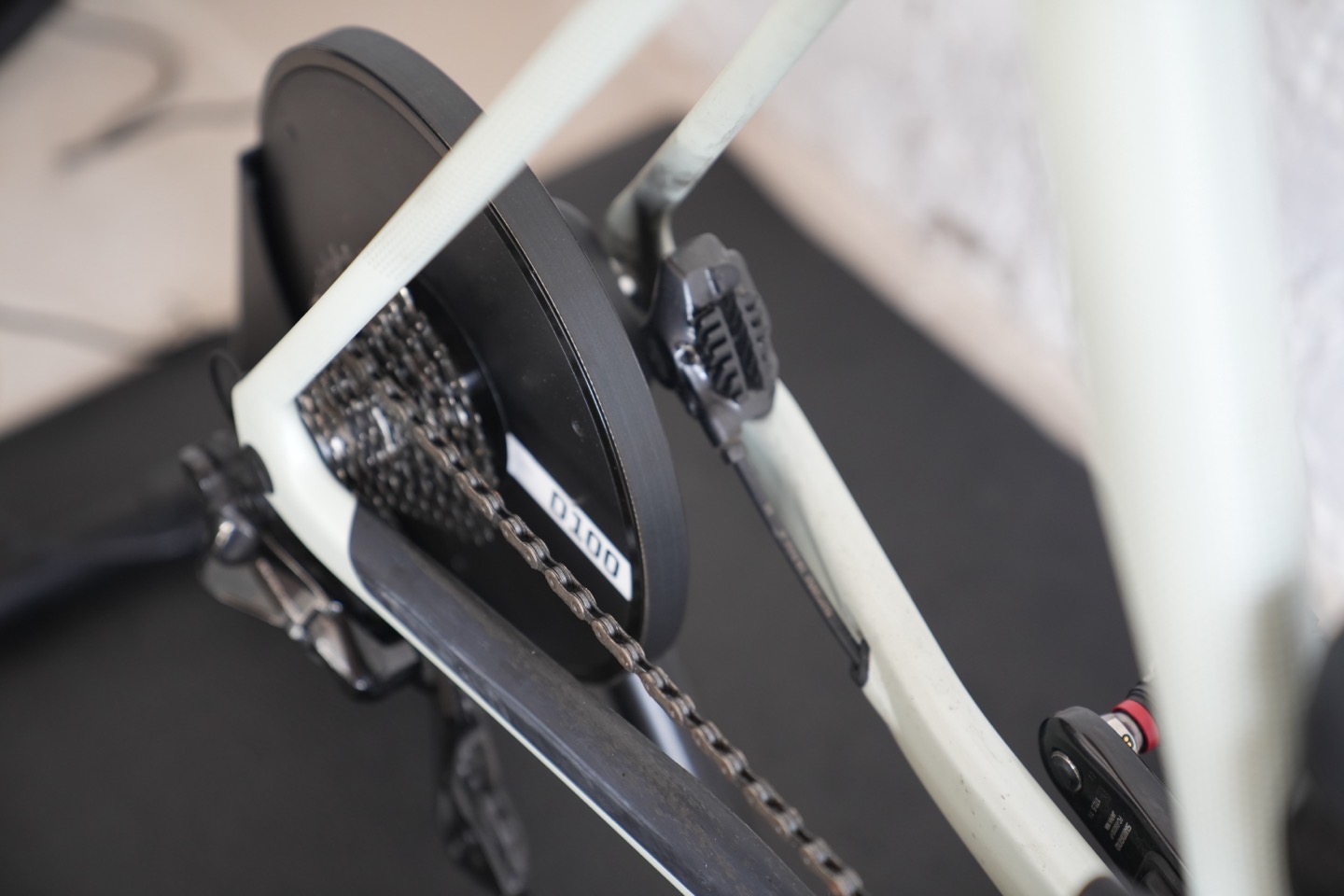
In many ways, I suspect this will likely be the first of a few salvos back and forth between Zwift & Rouvy. Or, maybe not. Maybe Zwift will simply say ‘shrug’ and move on, focusing instead on Zwift as a game, and the (quite excellent) Zwift hardware (such as the Ride and Cog/Click). As much as Zwift wants to gatekeep the Zwift protocol, Zwift has to remember they built their entire company on open protocol standards. And this goes in direct opposition of that.
One shouldn’t overlook the fact that Garmin has held back on doing Zwift Cog/Click. My discussions indicate they are keenly aware that if they were to jump into that arena, without protocol openness, it’d pretty much kill off the rest of the indoor trainer apps within 1-2 years.
As for Rouvy’s implementation, it’s a bit too early for me to know what longer-term or quirky caveats there might be. Obviously, I see some around trainer compatibility that Rouvy is working through. And if Zwift & Rouvy get into a technical cat & mouse fight club, then things could get messy. But practically speaking, due to the archaic and clunky-ass way that trainer firmware is updated across all companies, that makes things near impossible to play cat/mouse, because it’d break their own customers. Until then though, I’m sure this will make lots of Rouvy users happy (and maybe soon FulGaz customers too).
Oh, speaking of which…Rouvy has decided to let FulGaz live on, complete with getting software updates for the next few years. They’ve come to realize there’s value in keeping both apps and servicing both crowds. But more on that later.
With that, thanks for reading!
FOUND THIS POST USEFUL? SUPPORT THE SITE!
Hopefully, you found this post useful. The website is really a labor of love, so please consider becoming a DC RAINMAKER Supporter. This gets you an ad-free experience, and access to our (mostly) bi-monthly behind-the-scenes video series of “Shed Talkin’”.
Support DCRainMaker - Shop on Amazon
Otherwise, perhaps consider using the below link if shopping on Amazon. As an Amazon Associate, I earn from qualifying purchases. It doesn’t cost you anything extra, but your purchases help support this website a lot. It could simply be buying toilet paper, or this pizza oven we use and love.









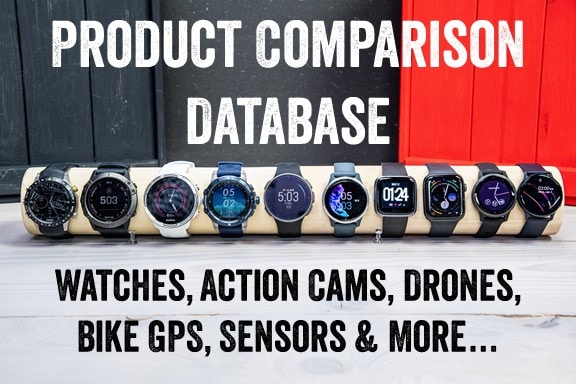


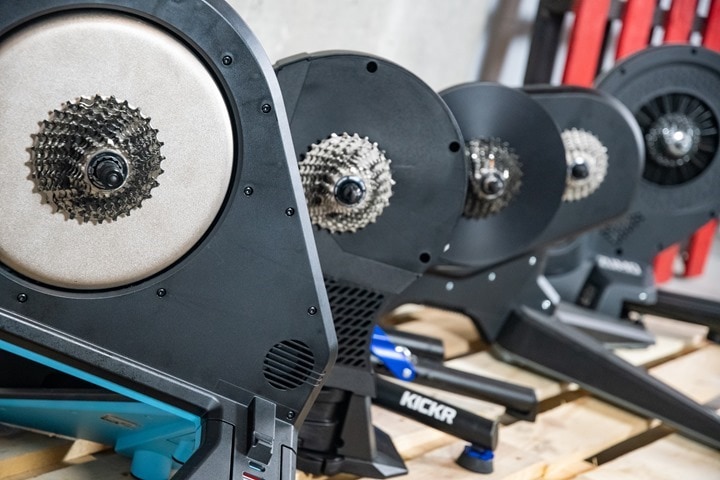






If it does not work on zwift play then I will not return to ROUVY. I understand that Zwift PLAY will not add on apple TV, but why not add on MAC and PC.
you can use QZ for this link to github.com
I smell lawsuit, might be similar to situation where Hammerhead used di2 protocol without Shimano permission.
I guess closed Zwift ecosystem is what keeps a lot of users (like me) having click/cog/play from switching to different platform.
I guess their patent end somehow in the 2024, that’s why also mywhoosh is moving to virtual gear this year
I would never use it where the noise doesn’t matter.
But where the original shifter makes loud noises, it’s a really useful tool.
Qz creator here, let me know if you have any questions
Since Wahoo Kickr V5 does not support virtual shifting, will QZ work with V5, Zwift Click and Rouvy for virtual shifting?
yes check this! link to github.com
Same question! I’ve been waiting for this to happen for quite a long time because I use an old mechanical group set, and it’s not super reliable with the setup I’ve got right now. I do mostly ERG mode training, but I would like to have virtual shifting.
Yes it does! Check here link to github.com
Yes it does as I said above. Check here link to github.com
It’s sad to see how everyone keep improving and the big blue elephant that is Garmin/Tacx have not yet been able to 100% integrate their platform. Instead of adding new functions it seems that we are losing them.
you can use QZ for this link to github.com
It’s compatible also with Garmin and Tacx allowing virtual shifting to all the platforms!
(Copying a similar response I gave on a YouTube comment about the Garmin/Tacx side of things)
It actually depends on one’s perspective. At first glance, I’d agree. But in reality, they’re actually holding Zwift’s feet to the fire. I short, if Garmin/Tacx enables virtual shifting and goes the way of the Zwift Cog (setting aside today’s reverse engineering), then within 1-2 years, all other indoor trainer apps will go away. Like, hard stop, they’ll fold. As a result, Zwift will be free to do whatever they want pricing-wise, as well as feature-wise. In effect, it becomes a monopoly. For once, Garmin is actually doing consumers a favor here, even if Garmin has various motives for it. And even if it kinda sucks for consumers in the meantime.
Can you spell this out for us? Why would all other indoor trainer apps go away?
Because trainers would cease to support them, since there wouldn’t be a method to shift.
Meaning, that as new trainers launched, many of them wouldn’t even bother to offer mechanical cassette versions. In fact, we see this already with trainers like the JetBlack Victory (at some point it will, but they along with others have been pressured by Zwift to offer Zwift Cog editions first).
Without mechanical cassettes, those trainings for the vast majority of the population are useless in 3rd party apps, aside from ERG mode. And even that isn’t a guarantee. One company I talked with was looking at only releasing a Zwift Protocol version of their trainer, so no other standards on it.
While 2 years worth of new trainers might not sound like a lot compared to the existing use base, the reality is that’s a ton %-wise of new users to the sport, or people on existing platforms. Almost none of these apps are rolling in the dough financially, and thus killing off even 10-30% of their user base over a 2-year period is enough to cause them to go out of business.
> if Garmin/Tacx enables virtual shifting and goes the way of the Zwift Cog (setting aside today’s reverse engineering), then within 1-2 years, all other indoor trainer apps will go away.
Help me, because I don’t follow.
Why would Garmin enabling virtual shifting kill off non-Zwift training apps?
The way I see it, and clearly I’m not seeing something you’re seeing, is that the Zwift controller and Zwift Cog are hardware options. So how does supporting one additional option kill off services that don’t use said option?
Thanks!
> In fact, we see this already with trainers like the JetBlack Victory (at some point it will, but they along with others have been pressured by Zwift to offer Zwift Cog editions first).
Does the JBV not have a standard freehub?
Because it’s not just about supporting it, it’s about offering it and which version retailers have and pitch. We see that with Elite today, on their Cog enabled offerings, or Wahoo for that matter. Sure, they sell the non-Cog options, but as seen with the KICKR CORE, the deal has consistently been substantially better when paired with Zwift Cog, thus, people get that instead.
As for JetBlack, it has a standard freehub, but very few users will ever switch (well under sub-10%).
I had thought that Garmin had gotten rid of their trainer design group (and much more recently hired a new one) and weren’t actively developing stuff for their trainers. Good to hear that’s not the reason that hey haven’t implemented virtual shifting like I had thought it was.
Nope, definitely not. Bigger than ever (in terms of people, facilities, and distribution/numbers).
Very odd, I was hoping this was done through a partnership, otherwise that protocol has been reverse engineered like at least over a year ago by other competitors (although there are notable trade offs with that approach).
Ray do you think there is any chance that Zwift may open the protocol in the short term?
And if they don’t do you think it’s going to be a good idea for others to open source the reverse engineered version?
Actually the QZ implementation is already open source! link to github.com
“Ray do you think there is any chance that Zwift may open the protocol in the short term?”
Not sure. But, one does have to remember that when Zwift first announced the Zwift Cog (with Zwift Hub variant), they had committed to making the connectivity available to 3rd parties, including apps. They’ve since tried to walk that back.
So is the Zwift Hub One not supported? I got everything hooked up this morning and the “click” changed the numerical gears, but there was no change in resistance.
Same problem. Today I installed on macOS, connected zwift hub one and zwift click. The virtual gears on the screen change, but the resistance of the trainer is still the same without change.
This reminds me of when someone reverse engineered the protocol for the elite sterzo. Elite and zwift promptly updated the firmware/protocol to stop others from using it. I can only imagine zwift will do so here again in the name of ‘security’
The difference is it’s a heck of a lot easier to do with the Sterzo than break everyone’s trainers. Sterzo has a relatively small userbase (very small), when they launched. Versus this would require either forcing a click update (totally plausible), or a trainer update (very challenging).
Zwift semi-forces Zwift Ride/Click updates more frequently, so that’s not a huge deal per se. But whether they want to engage in that cat/mouse game long-term is anyone’s guess.
Do you know how does it work, because IMHO, Cog is just single speed adapter, Click/Play gizmo that sends only key presses to app. Final part is function f(grade, gear) -> resistance and to stay away from vendor specific code in Zwift, such conversion is done in trainer firmware. So changing Click/Play protocol won’t affect trainer – Am I right?
I don’t understand with Zwift isn’t suing Rouvy.The Click Bluetooth protocol is trivial. Any decent programmer can use Android wireless debug facilities to reverse engineer the Click shifter. The problem is: The US DMCA prevents reverse engineering of proprietary protocols – even ones as simple as Zwift’s. What is Zwift’s position on a competitor using their hardware?
Reverse engineering isn’t actually prohibited by DMCA as a blanket statement.
However, DMCA does prohibit it in certain/specific scenarios (and allows it in others). Whether or not Rouvy crossed those boundaries requires a bit more inspection, some of it from Rouvy’s perspective, and some of it at the protocol level.
And… One more thing (pun intended)… Apple will remove apps from their App Store that use undocumented proprietary protocols. I once had to provide a letter from a smart bike manufacturer saying it was OK to use their Bluetooth commands to get my app approved.
The DMCA specifically allows reverse engineering for interoperability in § 1201.
Anyway, the DMCA is about encryption as a means to enforce copyright protection, not about protocols, so it doesn’t really have any relevance.
I wonder if this is a strategy to attract new users to Rouvy, even if, in the worst case, Rouvy receives a cease-and-desist letter from Zwift. By that point, they may have already gained new users who signed up for the annual plan.
“I wonder if this is a strategy to attract new users to Rouvy,”
It worked. I don’t have a Zwift Bike or Click controllers. I joined Rouvy today to support them. They are doing something that has some legal risk. I am happy to help them out.
Okay, I am trying to wrap my feeble little brain around what I might be able to do and what I can not do. I don’t mind paying for something that will work but I don’t want to waste time and money only to find out that it will not work.
I use Rouvy with a Saris Hammer H3 trainer.
Will I be able to use the Zwift Cog on it?
How about the Zwift Click?
Thanx for any help or info that anyone has.
The Saris H3 doesn’t support Zwift Virtual Shifting at this point. Saris says they’re working on stuff, but…timelines remain heavily fuzzy.
(One has to remember Saris was sold off, engineering basically gutted, and thus…yeah. Recent backstory there: link to dcrainmaker.com)
If you want virtual shifting with saris works with qz
Let me know if you have any questions
Thank you,
Jim
What is qz??
How does it work?
It’s also explained in the article, check here link to github.com
Engineer here interested in technical details but don’t have a good understanding of how virtual trainers work. I have a bike with 2×11 gearing on my Kickr Core and am using Rouvy. I gather that if I install a Zwift Click that I can start using virtual shifting in Rouvy. So what about my existing geartrain? What happens if I shift among various cogs? Does the virtual shifting act as a gear-reduction multiplier or ??? I guess my concept of virtual shifting was sort of what FulGaz does via software in its “slope scaling” feature, but again just not sure.
Thank you because I also simply do not understand. I already shift on my bike every ride. What would I possibly gain by doing it with a button. It is already not real so what is the point? Not trying to be a dick I simply just do not understand the benefit. I hope it’s more than simply chain alignment
As was the case before Rouvy, the main appeal of the Zwift Cog (and Click) is in cases where you have multiple bikes sharing the same trainer, with differing cassette types. Else, if you try and use a 12sp bike on an 11sp cassette, it won’t shift properly. This solves that (and all sorts of other variants).
For people with a single bike on a trainer, the only real gain is using a button to shift, instead of your shifters. That can be a bit quieter in some cases.
But from an electronics standpoint, there’s nothing in the Cog at all. It’s literally just a single cog of a cassette. Instead, the trainer is told what to do by Zwift, and works out where it needs to be based on flywheel speed and other variables.
To your question on what happens if you shift mechanically, it depends on the scenario. If you have a Zwift Cog, and shift in the rear mechanically, it creates a giant racket and your chain basically falls off (but is held in between the plastic parts). If you don’t have a Cog, and just have a cassette on (like I did above), then if you shift mechanically, it’ll take a few seconds and the trainer will normalize again. There’s actually good reasons to do that, especially in the case of the Decathlon D100, which has a bit more limited range. By changing my physical gears, I’m effectively giving it a bit more range, because I’m changing the flywheel speed (and flywheel speed is what matters when it comes to max power).
This is even more true on 1x bikes (a single front ring). For example, on both my gravel bike is a 1x13s, and on the Elite Direto XR COG, I can’t get the speeds low enough for some structured workouts. It basically bottoms out too high that I’m pushing quite a bit more watts that the workout says it should be pinned at. Whereas I don’t have that problem with a normal cassette.
Long story short, as with before, the main benefit of COG+CLICK is really multi-bike scenarios for consumers. And for Zwift/trainer companies, it’s the ability to only have to stock a single casette type, rather than a multitude of cassettes (some of which cost a heck of a lot more than the cost of a Zwift Cog).
What about gear range? Is the range of the 24 choices in Zwift larger than the typical range of a road bike? I use an old 3×9 road bike (from 2000) on my trainer, and the gearing really isn’t suited for something like the “Bonus Climb” or “The Grade”. I can struggle up with reduced cadence, but being able to use virtual gearing would be better if the low virtual gears were smaller. Of course, since my trainer is a Tacx Neo 2, this is only a dream.
The range and spacing is better than any physical bike. You get 24 evenly spaced ratios across a range that you can set to be pretty much as wide as you want. There are no redundant gears like in a 2X configuration and the spacing is even.
So, if I’m understanding, and I’m not complaining everyone can do themselves the way they want, the button shifting would provide an advantage to people they might not necessarily have in the real outside? Either range, or engagement speed, or being able to closely match ratios to their ideal for that particular person’s strength or cadence. I do not care what anyone else does for themselves, I’m just curious. I truly believe that when I see people pass me at 7+ w/k over and over for lap after lap it’s just a world tour rider under an assumed name 😉
So the Zwift Ride shifters are compatible? Or does one need to buy the click on top?
Correct, compatible.
FWIW, my guess is that Zwift doesn’t mind too much that Rouvy is doing this. Again a guess, but I a Zwift concern and why they don’t make this an open protocol, might be competing with MyWhoosh. MyWhoosh might be someone they end up suing, if it
MyWhoosh is not a real business. They say they will be ad-supported sometime in the future, but that is BS. It’s supported by a detestable government in an effort to sportswash their terrible reputation. Their existence seems, in itself, anti-competitive.
This might help them sell more Zwift Rides, not that I think Zwift is making much money from them, but it should help the price come down over time.
I have a dedicated trainer bike, and prefer my physical shifters over virtual (they are already there after all) but my trainer did come with a click and cog, I am now thinking I might use the click as an “over gear” As a recent zwift to rouvy user, I find the downhills to be more drastic than zwift and I often run out of gear, thinking I am might try to use the click to have some extra resistance when needed.
I find this all “interesting” as not long ago we (Ray and others) complained of smart bikes that had buttons and not actual shifters to mimmick real life. Now, everyone is on board going to buttons instead of shifters. I have Zwift play controllers for in game commands etc. but have no desire to shift with it (my Tacx trainer wouldn’t do it anyway). But, I prefer to be as realistic as possible. Why does everyone want to get away from realism? Zwift cog and and click upgrade kit is $80 and Zwift controllers and add a Microshift cassette for a trainer and your’e at yep, about $80? Your trainer doesn’t care if your cassette is Suntour or Dura ace? Weight isn’t an issue indoors. So, why wouldn’t you stick with real shifting? Is the only reason this is an issue is that some trainers are shipping with the cog and click and people save the $30 to $60 for a cheap cassette all at the expense of giving up realism and being locked into one and now maybe two apps?
Even on Zwift’s website a Wahoo Kickr core with cassette is $499.99 and a Wahoo Kickr core with cog and click is $499.99. Why wouldn’t you get the cassette so you could use the other dozen or so apps on the market if you wanted? Tacx, Kinomap, bkool, trainerday, xert, indievelo, mywoosh, just to name a few. Just don’t understand why this is a thing.
See Ray’s comment which sums it up pretty well:
“, the main appeal of the Zwift Cog (and Click) is in cases where you have multiple bikes sharing the same trainer, with differing cassette types. Else, if you try and use a 12sp bike on an 11sp cassette, it won’t shift properly. This solves that (and all sorts of other variants).
For people with a single bike on a trainer, the only real gain is using a button to shift, instead of your shifters. That can be a bit quieter in some cases.”
I would add that virtual shifting can provide more/as many gears as you want and any gear ratios.
And while there is something to be said for realistic road feel, bike operation, etc, of the equipment, all realism considerations pretty much go out of the window once we are talking about Zwift et al. (90s graphics, no real drafting, mismatch between visuals and course demands (especially in ERG),…)
Apparently you can’t just buy the clicker by itself?
Nice,
now we need Wahoo to wake and publish a firmware for the kickr v5 to support zwift virtual shifting instead
of pushing customer to upgrade to the v6.
Now if Wahoo isn’t moving, I will happily switch to a new trainer, probably the Jet Black one that my
local shop has in stock for half the price of the kickr v6, instead of paying wahoo for some maintenance partd.
I use Zwift, Rouvy, Trainerroad for workout.
I tried Kinomap but no good result,
You can use virtual gear with you trainer with qz already! link to github.com
How about someone would not come with open protocol which would do virtual shifting one any device or app like the QZ.
And ask trainers manufacturers to implement that instead. People like the solution but would prefer to use any app. So if all other app companies get together and develop this + relevant shifter app implementation or hardware and do it in competition to zwift. Then suddenly zwift could have a problem and would either have to implement that open protocol in their app and controllers no? In the end cog or cassette doesn’t do anything.
The problem is there’s no longer any teamwork among manufs, thus, they found themselves in this pickle. There used to be, back in the days of the ANT+ Symposium, focused on standards (even within BT FTMS from a timeline standpoint). But those days are gone.
Ironically, all these hardware companies actually want those days back, when I talk to them individually. They all agree there’s huge benefits to standards. But getting them to agree on a date/time/concept has been tricky.
Don’t smartbikes do virtual shifting within the bike itself without relying on Zwift? Why couldn’t trainers include clickers that likewise control resistance directly instead of via Zwift? Wouldn’t need an open standard then.
Old Stages SB20 have native virtual shifting, right?. What’s the big deal to include virtual shifting in all trainers?
Ray, Just interested in your throw away comment about Rouvy keeping Fulgaz going in parallel for a few more years.
Rouvy will not comment on this to Fulgaz subscribers.
Is it true? Where did the info come from?
Thanks.
It’s coming from Rouvy. They’re going to send out full details/plans the last week of Feb. In short though, they’re realizing/seeing significant value in keeping FulGaz around and having two apps that effectively cater to two sides. There will be a divide of sorts in what content goes where (Ironman content will go to Rouvy, for contractual reasons).
They’re seeing more clearly now that FulGaz competes in a slightly different overlap with other training apps that Rouvy may not directly compete with. But again, more shortly.
Many thanks Ray.
Interesting that they choose to release information to you but not subscribers but much appreciated all the same.
Is it possible to buy a Click controller without the cog? I looked on the Zwift site and only see them paired. I don’t need a cog and would like to save some money (especially if this might not last due to possible legal troubles).
Zwift play controllers available separately…perhaps you were considering those too pricey for what they are?
Yeah, I don’t need those, too big and too expensive. I’m cheap :)
Another hand shooting in the air for clarification on the FulGaz death sentence delay. Can’t find any confirmation via Rouvy media. Can you say a bit more about where that info is coming from? Some of us here are guardedly giddy…
So will a Zwift Ride bike shift through a Rouvy non-Erg route after just adding the Rouvy update?
Can someone educate me, please? What is the value of virtual shifting? I don’t see the point. Why not just actually shift? What am I missing here?
If you already have a smart trainer setup with a cassette, not much.
I for example bought a jetblack victory that came with the zwift cog/click, now I can use other apps without the need for buying a cassette. Also it is much easier to use a trainer for multiple people with the zwift cog as you don’t really need to worry about cassettes, deraileur setup, etc.
Ray, do you know if there is a restriction on how the trainer needs to be paired?
My Kick’r Move is paired to Rouvy via ANT+. I don’t see the virtual shifting.
I reached out to Rouvy and have gotten very wishy-washy answers as to how things should be configured.
Thanks
-marc
I confirmed today, that virtual shifting is only available if the Kick’r is paired via BTLE.
Ray, any idea why?
Thanks
-marc
Correct, Zwift Virtual Shifting (Zwift Protocol) only occurs via BLE. It doesn’t exist on ANT+.
Cheers!
Ray, do you know why? I am pretty certian with Zwift and the Kick’r Move virtual shifting works across ANT+, BLE, WiFi and Direct Connect. I think I played with it a bit when it first was released and I was paired with ANT.
Thanks for the write up! Good to know the Click can be used without a Cog. May have to pick one up to finally be able to use my gear limited 1X on Rouvy for completing rides at 100% realism without spinning out or absolutely mashing the steeps!
Does this work for anyone with Zwift Hub One? I’m changing virtual gears but the resistance of the trainer is still the same without change
Same issue for me
According to Rouvy only the Kick’r Gen 6, including the Move, and the Core are supported.
link to support.rouvy.com
ROUVY, the indoor cycling app that lets you ride real routes around the world, is launching an update this week allowing full compatibility with Zwift hardware, including Ride, Click and Cog.
Their site indicates otherwise. Full compatibility with zwift hardware should include the Hub.
Tried today and works immediately. No worries at all. Great move by Rouvy
BTW: Setup is Zwift Ride
Too bad you can’t buy the Zwift Click by itself. You have to buy the click cog as well for $80.
I have a Zwift hub and for some reason, this new update on Rouvy has caused my hub to think it’s in one gear. I have a standard cassette and do not have a clicker…just my standard shifters. I submitted a ticket, but Rouvy is unrideable. Yesterday I could not put any more watts out past 91 and I was in my tallest gear and a cadence of 90. Literally could not go any faster. Only the slope would change my speed.
Bonjour
J’ai lu une bonne partie du sujet ci-dessous mais je ne comprends toujours pas le fonctionnement de ce mode virtuel :
Concrètement, j’utilise Rouvy avec le NEO 2T équipé d’une cassette 11 vitesses 11/32 sur un vélo équipé d’un groupe méca shimano 105 avec plateaux 50/34
pour passer en mode virtuel quels changement je dois apporter ?, est ce que ce mode virtuel simule bien mes braquets actuels à savoir 50/34 et 11/32 sinon je n’y vois aucun intérets
Cordialement
Jérôme
You can’t use Zwift virtual shifting with a Tacx trainer. Rouvy has reverse engineered the virtual shifting protocol that Zwift developed, and that only works for certain trainers. No Tacx trainer can use Zwift virtual shifting.
Merci pour la réponse
Ok pour la non compatibilité du Tacx
Mais éventuellement pour un home trainer qui serait compatible
est-ce que ce mode virtuel simule bien par exemple les braquets shimano 50/34 et 11/32, sinon je n’y vois aucun intérets
Cordialement
You can use virtual shifting with the qz app on all the app with your tacx!. Check this link to github.com
Merci pour la réponse
mais j’en reviens également à la même question
est-ce que ce mode virtuel simule bien par exemple les braquets shimano 50/34 et 11/32, sinon je n’y vois aucun intérets
Cordialement
I use Zwift hub, Zwift click both and rouvy all with the current update. all sensors connect as they should. I can shift virual gears in rouvy but the trainer resistance is not affected. yes, the control is set up with the hub. any idea what I could do?
Thx Nic
Ich habe die Lösung des Problems gefunden: Die aktuelle Rouvy Version 3.10.3 verursacht den Fehler. Ich habe 3.10.3 deinstalliert und Version 3.10.2 installiert. Ergebnis: Die Schaltung funktioniert, wie sie soll. Also benutze Version 3.10.2 und mache nicht das Update auf 3.10.3!
I found the solution to the problem: The current Rouvy version 3.10.3 is causing the error. I uninstalled 3.10.3 and installed version 3.10.2. Result: The circuit works as it should. So use version 3.10.2 and don’t update to 3.10.3!
Ich habe das gleiche Problem, wie es in den Kommentaren #23,24,74,75 beschrieben ist. Ich habe den Zwift Klick mit Cog in der Rouvy-App (aktuelle Version 3.10.3.158) gekoppelt. Trainer ist ein Zwift Hub One. Wenn ich auf der Rouvy-Strecke mit Klick schalte, wird der Gangwechsel auf dem Display angezeigt. Die Übersetzung ändert sich aber nicht und es ist kein Lastwechsel zu spüren. Auf der Zwift APP schaltet der Klick normal, also mit Gang- und spürbarem Lastwechsel. Dabei spielt es keine Rolle, ob ich die App auf dem Windows PC oder dem iPad laufen lasse. Leider konnte ich im Forum keine Lösung zu diesem Problem finden. Vielleicht hat jemand eine Antwort darauf.
You state that only hardware on a compatible trainer(wahoo kickr core) required is The Zwift Click and you don’t need the zwift cog. Is it possible to purchase just the zwift click. I can only see
link to us.zwift.com
Currently I can see my trainer on ROUVY under virtual gearing but it won’t connect seemingly with out the zwift click
It’s not available to purchase just the Zwift Click at this point, but rather a bundle with both. That said, you don’t actually have to install the Cog if you don’t want to.
Hi there,
do you know if this will work with the new JetBlack Victory trainer with Zwift cog in Rouvy?
switche from Zwift to Rouvy six month ago, love it (realism) never go back. Using Zwift Hub and after a little work, its fine.I run campy, so of course a campy hub is a no no. switched to a cheap Shimano set and is better but noisy. after a few upgades on Rouvy I have found I no longer need to shift. Uphill harder, down easier. I can’t shit, only mechanically, but no need to. I have Zwift game controller and of course they do not work My fear is any of Rouvyies future updates will ruin this.